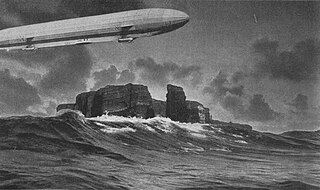
Zeppelin LZ 14, given the navy tactical number L 1, was a rigid airship built for the Kaiserliche Marine to carry out reconnaissance over the North Sea and enemy territory. It was first flown on 7 October 1912. On 9 September 1913, LZ 14 was on a patrol over the North Sea when it encountered a thunderstorm, which resulted in a forced landing/crash. Fourteen crew-members drowned, becoming the world's first ever Zeppelin casualties.

The Imperial German Army Zeppelin LZ 47 was a P-class World War I zeppelin. Destroyed by enemy fire on 21 February 1916 in the Battle of Verdun, killing the crew of 15.
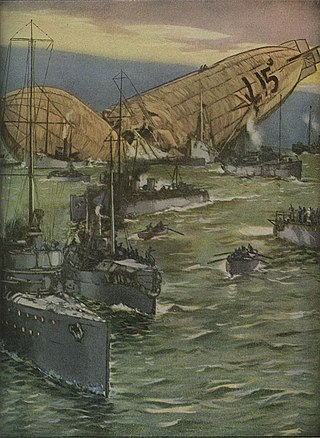
The Imperial German Navy Zeppelin LZ 48 was a P-class World War I zeppelin.

The Imperial German Navy Zeppelin LZ 53 was a P-class World War I zeppelin.

Zeppelin LZ 38 was Zeppelin P Class airship of the German Imperial Army. It was the first to bomb London, United Kingdom.
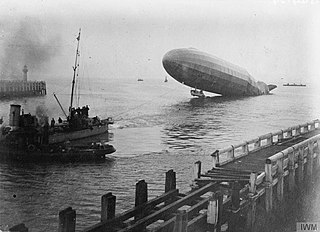
The Imperial German Army Zeppelin LZ 43 was a P-class World War I zeppelin. While taking part in a bombing raid of the United Kingdom the Airship was hit by AA fire and it crashed outside of Ostend, Belgium on 10 August 1915. While being towed into the harbour, it burst into fire.

LZ 72 was an R Class super-zeppelin belonging to the Imperial German Navy. It was commanded by Kapitänleutnant Heinrich Mathy, an experienced commander, and took part in several raids over London during World War I. It also participated in a reconnaissance role during the Sunderland raid of 19 August 1916. Its last flight was launched late at night on 1 October 1916. Several miles north of London, it was caught in searchlights and anti-aircraft fire. During this engagement, 2nd Lt. Wulstan J. Tempest was on patrol and spotted the zeppelin. He proceeded to engage the airship with incendiary rounds, causing the ship to burst into flames and crash in a field near Potter's Bar. The entire crew died, and were originally buried there but were reinterred at Cannock Chase German Military Cemetery in the 1960s. After this disastrous crash, the Imperial German Navy began reducing the number of zeppelin raids.

The Imperial German Navy Zeppelin LZ 31 was an M-class World War I Zeppelin.

The Zeppelin LZ 23 was the 2nd improved L-class Zeppelin, and the eleventh airship of the Imperial German Army, first flown on 21 February 1914 and shot-down by anti-aircraft fire on 23 August 1914.

Zeppelin LZ 55 was a P-class Zeppelin of the Imperial German Army in World War I. It was shot down by the old British pre-dreadnough battleship HMS Agamemnon in 1916 during Salonika campaign

M2-class zeppelin LZ 32, given tactical number L 7, was a rigid airship operated by the Kaiserliche Marine, which flew 164 times, including 77 reconnaissance missions over the North Sea, with several unsuccessful attempts to attack English coastal towns. Brought down on 4 May 1916 by anti-aircraft fire from HMS Phaeton and HMS Galatea, she was destroyed by Royal Navy submarine HMS E31 off Horns Reef.

The Imperial German Navy Zeppelin LZ 112, given the tactical number L 70, was an x-class / L70-class World War I zeppelin of the Imperial German Navy.

The Imperial German Navy Zeppelin LZ 64, given the tactical number L 22, was a Q-class / L20-class World War I zeppelin of the Imperial German Navy.
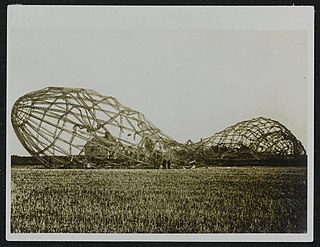
The Imperial German Army Zeppelin LZ 76 (L-m33) was a R-class World War I zeppelin.
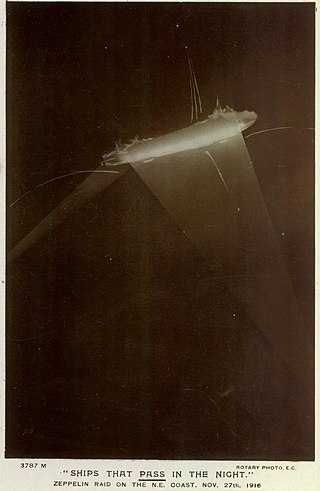
The Imperial German Army Zeppelin LZ 78 (L-34) was a R-class World War I zeppelin.

Zeppelin LZ 89 was an R-class zeppelin of the Imperial German Navy. After a short career during the World War I it ran out of fuel during a mission and was deliberately crashed.

LZ 74 was an R Class super-zeppelin belonging to the Imperial German Navy.

The Imperial German Navy Zeppelin LZ 86 (L-39) was a R-class World War I zeppelin.

The Imperial German Navy Zeppelin LZ 24 was a M-class World War I zeppelin.

The Imperial German Navy Zeppelin LZ 29 was an M-class World War I Zeppelin.
This page is based on this
Wikipedia article Text is available under the
CC BY-SA 4.0 license; additional terms may apply.
Images, videos and audio are available under their respective licenses.




















